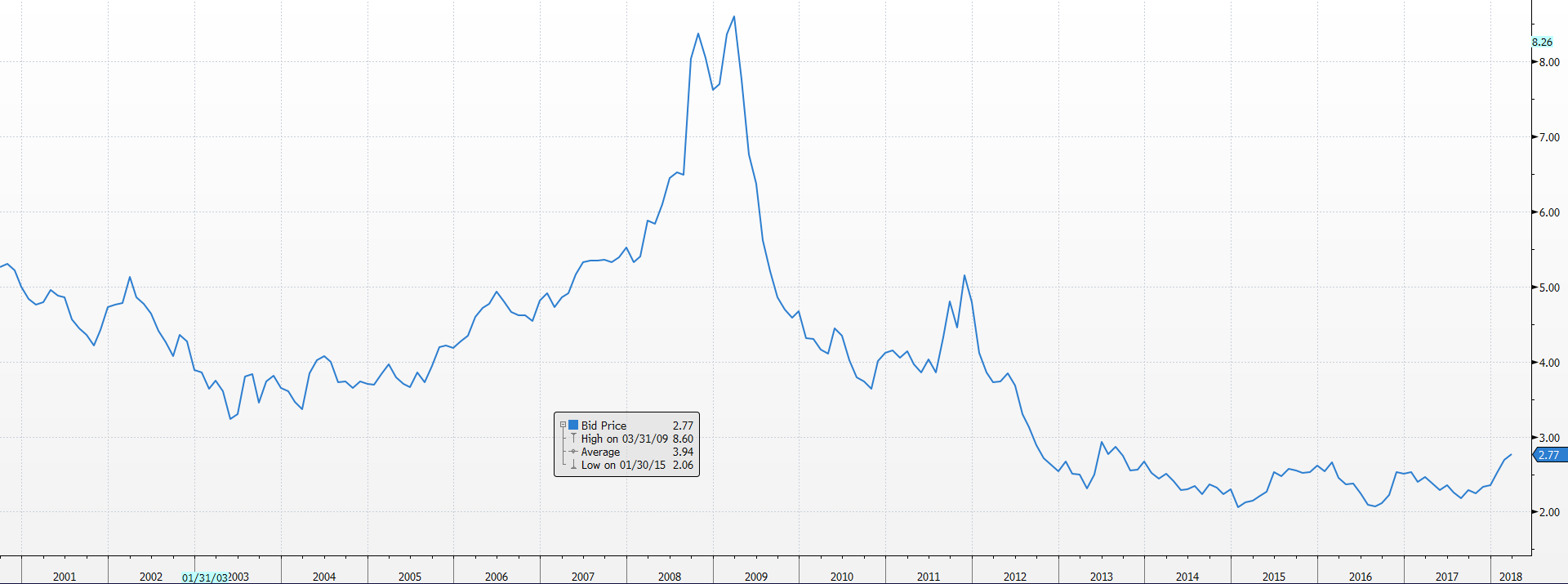Quarterly Outlook
Upending the global order at blinding speed
John J. Hardy
Global Head of Macro Strategy
Head of Fixed Income Strategy
It was a warm mid-September day in New York City with Lehman Brothers filed for Chapter 11. That day marked the end of investment banking as we knew it and opened the way to a global financial crisis that brought many to their knees.
That fateful summer forever changed investors’ perception of banks and while before they were seen as institutions able to facilitate liquidity for businesses and individuals, now they were seen as greedy vultures ready to use taxpayer moneys in order to be rescued.
If we look at the Bloomberg Barclays Global Aggregate Financial Yield to Worst (below) we can see that in 2008 yields of global financials bonds spiked above 8% and since then, they have gradually retreated to lower levels. Today, financial bonds trade at considerably lower level than they did before the crisis; is it therefore worthwhile to hold financial debt risk?

Source: Bloomberg
The reality is that comparing banks pre-crisis against the ones we have today would be like comparing pears to apple. As a matter of fact, since September 2008 many regulations and prudential supervisions have been implemented in order to strengthen the financial system. Regulators not only implemented rules to discourage ill-motivated behavior by market participants, but also enforced reforms that have increased the capital which banks must hold, meaning that if things go badly these institutions would have a loss-absorbing buffer. At the same time, banks have now greater compliance obligations that add to their costs but steers them away from other types of operational and reputational risks.
It therefore makes sense for financial institutions' bonds to offer less yield than before because their business is considerably less exposed to leverage and risks. What is interesting, however, is that these credits are extremely more liquid than other corporate bonds, thus more sensitive to headline news. This is an aspect that can be used to one’s advantage in a diversified portfolio.
We can divide financials into five main categories: Retail banks, investment banks, safe havens, emerging and peripherals.
This categorisation strictly depends on the operating environment of the banks, and within each category there can be more or less risky institutions, depending on the health of the bank's balance sheet and the systemic support that this institution may or may not get from government.
This gives investors the opportunity to play headlines in the news even when there are no direct instruments that can be used for that purpose.
A good example may be Spain and the Catalonia crisis. Now that Catalonia’s problems seem to have limited economic impact on the country, rating agencies are lining up to raise Spain’s credit rating due to its impressive economy recovery. Already in January Fitch has raised its rating by one notch to A- and this week we are expecting a rating review by S&P that may follow Fitch to upgrade Spain to A-. The Spanish financial sector will benefit from a rating upgrade of the sovereign debt which could lead to a credit upgrade of the banks as well. Within this space financial institutions with exposure to Catalonia such as CaixaBank and Banc de Sabadell will be the ones to benefit the most and, in particular, their subordinated bonds spreads are the most likely to tighten as they are most sensitive to news.
This basically means that an investor can take advantage of the weakness related to the political volatility of Catalonia by investing in bonds that belong to banks with exposure to this region. It is true Catalonia has regional bonds, however, in comparison to the debt offered by the regional banks, it is much less liquid and it offers only a marginally higher yield that doesn’t correctly reflect the riskiness of the bond or the rating. Indeed, the bonds of Generalitat de Catalunya 4.22% 2035 have a rating of B+/BB with negative outlook from S&P and Fitch and offer an indicative yield of 3.5%, while Sabadell 5.625% 2026 with a rating of Ba3/BB offers a yield of approximately 3%. It doesn’t take much to conclude that earning 50bps for a maturity that is nine years longer and a worse rating doesn’t compensate investors.
Moving away from the periphery, it is important to note that this year may turn out to be a good year for the US banking sector. As a matter of fact, higher interest rates in the US may help interest margins to expand and these revenue gains should directly improve profits. In addition, the new tax reform will most certainly prove beneficial to this sector. Progress on deregulation is also a key theme to watch as it may enable bigger banks to increase their leverage ratio. The banks to benefit the most, however, will be US small- and medium-sized banks which will see a softening of regulations around lending practices and they will be potentially exempt from the Volcker Rule which at the moment is prohibiting lenders from proprietary trading.
In conclusion, the same banking sector that scared off investors ten years ago, may be the same industry that today, in a bearish market, may provide investors the tools to gain exposure to various political risk (such as Brexit, Catalonia etc) without being too risky as new regulations improved the capital ratio of the banking system and a default of better banks is less likely. Like any other industry, however, it is important to cherry pick and assess risk as nowadays nothing is risk free.